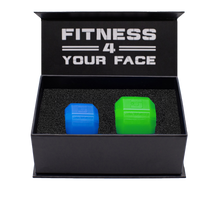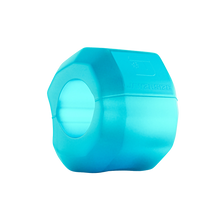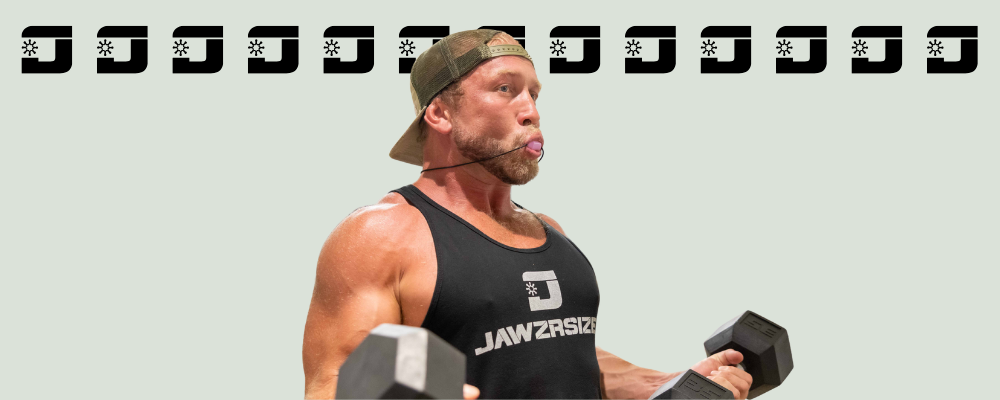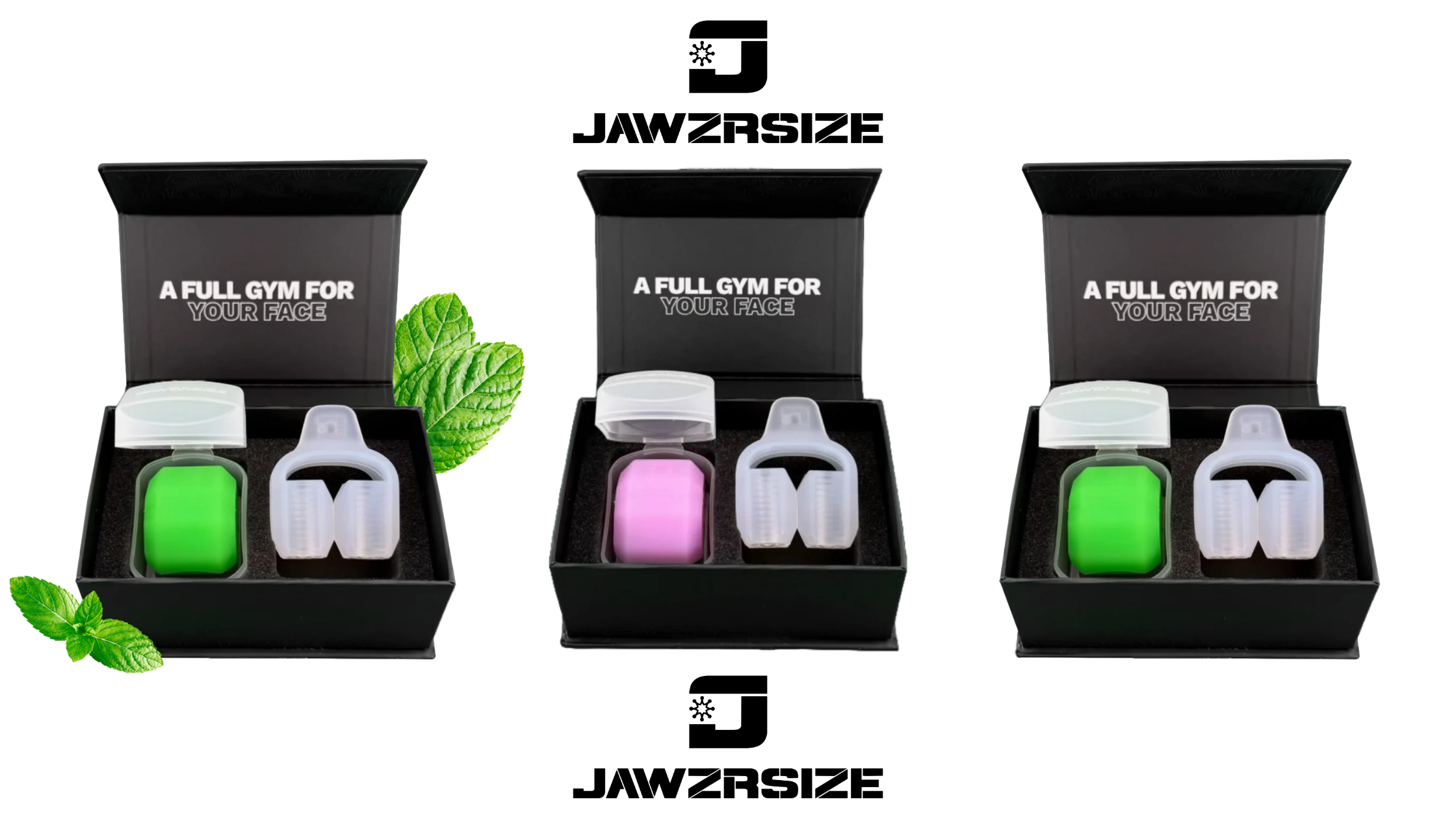Temporomandibular joint disorders, commonly referred to as TMJ, affect millions of people worldwide. If you're one of them, you know the pain and discomfort it can cause.
But there's good news. Specific exercises can help alleviate TMJ pain and improve jaw function.
In this article, we'll explore the best TMJ exercises for pain relief, helping you find the comfort you need.
What is TMJ?
TMJ refers to the temporomandibular joint, the hinge connecting your jaw to your skull. This joint allows you to move your jaw up and down and side to side, enabling you to talk, chew, and yawn.
TMJ disorders occur when there's a problem with your jaw and the muscles that control it. This can lead to pain, discomfort, and limited movement.
👉 Learn more: What Are Jaw Disorders and How Can Jawzrsize Help?
Symptoms of TMJ
TMJ disorders can cause a variety of symptoms, including:
- Pain or tenderness in the jaw, face, neck, and shoulders
- Clicking, popping, or grating sounds in the jaw joint when opening or closing the mouth
- Difficulty or discomfort while chewing
- Locking of the jaw joint, making it difficult to open or close the mouth
- A change in the way the upper and lower teeth fit together
- Swelling on the side of the face
- Toothaches, headaches, neck aches, dizziness, earaches, hearing problems, and ringing in the ears (tinnitus)
👉 Learn more: How Jawzrsize Can Help With TMJ Disorder? [Complete Guide]
Causes of TMJ
The exact cause of TMJ disorders is often difficult to determine. However, several factors can contribute to the development of TMJ disorders, such as:
- Grinding or clenching the teeth (bruxism)
- Dislocation of the disc between the ball and socket of the joint
- Osteoarthritis or rheumatoid arthritis in the TMJ
- Stress, which can cause you to tighten your jaw muscles or grind your teeth
Injury to the jaw, the joint, or the muscles of the head and neck, such as from a heavy blow or whiplash, can also lead to TMJ disorders.
Jawzrsize: Best Jaw Exercise for TMJ
Jawzrsize provides an effective method for individuals dealing with TMJ discomfort, offering targeted jaw exercises that help strengthen and relax the jaw muscles. By integrating resistance-based jaw exercises, Jawzrsize may reduce pain and enhance jaw functionality. Here’s a closer look at how Jawzrsize can support TMJ relief:
- Strengthens Jaw Muscles: Regular use of Jawzrsize targets jaw muscle groups, building strength over time, which can help stabilize the jaw joint and reduce stress on the TMJ.
- Promotes Jaw Relaxation: These exercises encourage relaxation of the jaw muscles, relieving tension that contributes to TMJ pain.
- Enhances Jaw Functionality: Improved muscle tone and jaw strength from Jawzrsize exercises can lead to better mobility, making daily activities like speaking and chewing more comfortable.
- Easy to Incorporate: Jawzrsize can be conveniently incorporated into daily routines, making it accessible for those seeking non-invasive TMJ management methods.
- Encourages Proper Jaw Alignment: Regular exercise may help promote alignment of the jaw, which is essential for reducing the symptoms associated with TMJ disorders.
By introducing Jawzrsize into your daily regimen, you may experience a reduction in TMJ pain and an improvement in jaw function, offering a drug-free and effective approach to managing TMJ symptoms.
Why Jawzrsize Kits Are the Best Solution for Improving Jaw Disorders, Especially for TMJ
Jawzrsize offers comprehensive kits specifically designed to target jaw disorders, including temporomandibular joint (TMJ) issues. These kits are thoughtfully curated to provide a progressive, results-driven experience for users seeking relief from TMJ discomfort while enhancing jaw muscle strength and function. Below, we’ll discuss why these complete kits are ideal solutions for TMJ management and jaw health.
1. Total Contouring Kit for Women
- Tailored for Women: The Total Contouring Kit is specifically designed with female users in mind, providing resistance levels that are ideal for building jaw strength progressively without overstressing the muscles. This kit caters to both beginners and advanced users, allowing for gradual progression.
- Complete Resistance Range: This kit includes multiple resistance levels, allowing women to progressively strengthen and tone their jaw muscles. Starting at a lighter resistance and moving up to higher levels helps users adapt their muscles gradually, reducing the risk of strain or discomfort.
- Enhances Jaw Contour: By engaging the jaw muscles through resistance exercises, this kit is designed not only to alleviate TMJ-related pain but also to promote a more defined jawline, offering aesthetic benefits alongside functional improvement.
- Non-Invasive and Convenient: With a focus on convenience, this kit allows users to incorporate TMJ exercises into their daily routines easily. It provides an effective, non-invasive alternative to medication or more intensive interventions, making it a valuable addition to TMJ treatment plans.
- Durable and High-Quality Materials: Jawzrsize products are built to withstand regular use, ensuring that users can rely on the Total Contouring Kit for long-term, consistent results.
👉 Click here and shop your Total Contouring Kit! Save up to 15% now!
2. Total Transformation Kit for Men
- Engineered for Male Jaw Strength: The Total Transformation Kit is optimized for men, with resistance levels that accommodate the typically greater jaw muscle strength found in male users. This kit encourages strength progression, allowing users to reach higher resistance levels over time.
- Advanced Muscle Training: This kit provides multiple resistance levels for gradual muscle conditioning, helping men build stronger jaw muscles that support proper jaw alignment and functionality. Progressive resistance encourages muscle adaptation and prevents strain, which is crucial for effective TMJ management.
- Improves Jaw Definition: With regular use, the Total Transformation Kit helps define and tone the jaw area, promoting a stronger, more structured jawline while addressing TMJ symptoms.
- A Holistic Approach to TMJ Relief: The Total Transformation Kit offers users a complete tool for addressing TMJ disorders, combining muscle strengthening with improved flexibility and jaw alignment. This holistic approach may significantly reduce TMJ pain and discomfort over time.
- Premium Quality for Intensive Use: Built to last, the materials in this kit are designed for high-resistance training, making it ideal for users who want a durable, reliable solution for long-term TMJ management.
👉 Click here and shop your Total Transformation Kit! Save up to 15% now!
Why Jawzrsize Kits Stand Out for TMJ Relief
Both the Total Contouring Kit and Total Transformation Kit offer a structured progression of resistance levels, allowing users to advance their jaw training safely and effectively. This progressive approach is especially beneficial for TMJ sufferers, as it enables gradual muscle strengthening, helping users achieve better jaw stability and alleviate TMJ-related pain.
- Professional-Grade Quality: As the most complete and high-quality kits available, they are a premium investment that offers long-term value by supporting continued progress and jaw health improvement.
- Designed for Convenience and Daily Use: Both kits are easy to incorporate into daily routines, providing a manageable and effective non-invasive solution for TMJ issues.
- Holistic TMJ Management: By addressing the root causes of TMJ discomfort, including muscle weakness and improper alignment, Jawzrsize kits promote healthier, stronger, and more resilient jaw muscles.
For individuals looking for a premium, all-inclusive approach to managing TMJ symptoms and improving jaw muscle tone, the Jawzrsize Total Contouring Kit for Women and Total Transformation Kit for Men are optimal choices. They provide the resistance progression needed for long-lasting relief and functional improvement, making them a top-tier investment in jaw health.
How do TMJ exercises help relieve pain?
TMJ exercises aim to stretch and strengthen the jaw muscles, increase flexibility, and improve range of motion. When performed regularly, these exercises can help:
- Relax tense jaw muscles
- Reduce pain and discomfort
- Improve jaw mobility and function
- Promote proper jaw alignment
- Prevent further damage to the temporomandibular joint
Incorporating TMJ exercises into your daily routine can lead to significant improvements in your symptoms over time.
Advantages of TMJ exercises over medication
While medications like pain relievers and muscle relaxants can provide temporary relief, they do not address the underlying cause of TMJ disorders. In contrast, TMJ exercises offer several advantages:
- Non-invasive and drug-free approach
- Can be performed at home without special equipment
- Cost-effective compared to long-term medication use
- Provide long-lasting relief by strengthening jaw muscles and improving joint function
- Minimize the risk of side effects associated with prolonged medication use
It's important to note that while TMJ exercises can be highly effective, they may not be suitable for everyone. In some cases, a combination of exercises, medication, and other treatments may be necessary. Consult with your healthcare provider or a TMJ specialist to determine the best course of action for your specific condition.
9 best TMJ exercises
Incorporating these nine TMJ exercises into your daily routine can help alleviate pain, improve jaw function, and prevent further damage to the temporomandibular joint. Remember to perform these exercises gently and stop if you experience any pain.
1. Relaxed jaw exercise
- Rest your tongue gently on the top of your mouth, behind your upper front teeth.
- Allow your teeth to come apart while relaxing your jaw muscles.
- Hold for 5-10 seconds and repeat 10 times.
2. Goldfish exercises (partial opening)
- Place your tongue on the roof of your mouth and one finger in front of your ear where your TMJ is located.
- Put your middle or index finger on your chin.
- Drop your lower jaw halfway and then close. Perform six times in one set.
3. Goldfish exercises (full opening)
- Keeping your tongue on the roof of your mouth, place one finger on your TMJ and another on your chin.
- Drop your lower jaw completely and back. Perform six times to complete one set.
4. Chin tucks
- Sit with your shoulders back and chest up.
- Pull your chin straight back, creating a "double chin."
- Hold for three seconds and repeat 10 times.
5. Resisted mouth opening
- Place your thumb under your chin.
- Open your mouth slowly, pushing gently against your chin for resistance.
- Hold for 3-6 seconds, then close your mouth slowly.
6. Resisted mouth closing
- Squeeze your chin between your index and thumb.
- Close your mouth as you apply gentle pressure with your fingers.
- Hold for 3-6 seconds and repeat 10 times.
7. Tongue up
- Slowly open your mouth and press your tongue to the roof of your mouth.
- Hold for 5-10 seconds and repeat 5-10 times.
8. Side-to-side jaw movement
- Place a ¼ inch object, like stacked tongue depressors, between your front teeth.
- Slowly move your jaw from side to side.
- Increase the thickness of the object as the exercise becomes easier.
9. Forward jaw movement
- Place a ¼ inch object between your front teeth.
- Move your bottom jaw forward, so your bottom teeth are in front of your top teeth.
- Hold for 5-10 seconds and repeat 10 times.
Other ways to manage TMJ pain
In addition to the exercises mentioned above, there are several lifestyle changes you can make to help manage TMJ pain and prevent further discomfort.
One of the most important things to keep in mind is to avoid clenching your teeth. This can be a difficult habit to break, especially if it's something you do unconsciously. However, making a conscious effort to relax your jaw muscles can go a long way in reducing TMJ pain. Practicing stress-relief techniques, such as deep breathing, meditation, or yoga, can also help you relax and reduce tension in your jaw.
Another way to minimize jaw stress is to eat a soft diet. This means avoiding hard, crunchy, or chewy foods that require a lot of jaw movement. Instead, opt for softer foods that are easy to chew and swallow, such as smoothies, soups, and mashed potatoes.
You should also avoid chewing gum, biting your nails, and biting your lower lip. These habits can put unnecessary stress on your jaw muscles and exacerbate TMJ pain.
Maintaining good posture is another important factor in managing TMJ pain. Poor posture can put extra strain on your neck and jaw muscles, leading to increased pain and discomfort. Make sure to sit and stand up straight, keeping your shoulders back and your head level.
Finally, try to limit large jaw movements, such as yawning, singing, or shouting. These movements can put extra stress on your jaw muscles and lead to increased pain.
When to see a doctor for TMJ pain
While TMJ exercises and lifestyle changes can be effective in managing TMJ pain, there are certain situations where it's important to seek professional medical help. If you experience any of the following symptoms, it's time to consult with a doctor or dentist specializing in TMJ disorders:
Chronic or severe pain that persists despite home remedies and self-care measures. If your TMJ pain is constant, intense, and interferes with your daily activities, it's essential to seek medical attention. A healthcare professional can help diagnose the underlying cause of your pain and recommend appropriate treatment options.
Difficulty chewing or speaking due to jaw pain or limited jaw movement. If your TMJ symptoms are making it hard for you to eat, speak, or perform other essential functions, it's crucial to consult with a doctor. They can assess the severity of your condition and provide guidance on managing your symptoms effectively.
Jaw locking, where your jaw gets stuck in an open or closed position. This can be a sign of a more serious TMJ disorder that requires professional intervention. If you experience jaw locking, it's important to seek medical attention promptly to prevent further damage to your jaw joint and muscles.
Swelling and tenderness in the jaw area that does not improve with home remedies. If you notice persistent swelling, redness, or tenderness in your jaw, it could indicate an underlying infection or inflammation that requires medical treatment. A healthcare professional can evaluate your symptoms and recommend appropriate medications or therapies to reduce swelling and discomfort.
In addition to these specific symptoms, it's always a good idea to consult with a doctor if your TMJ pain is causing significant distress or impacting your quality of life. They can help you develop a comprehensive treatment plan that may include a combination of exercises, lifestyle modifications, medications, or other therapies tailored to your individual needs.
Remember, while TMJ exercises can be highly effective in managing mild to moderate TMJ pain, they should not be used as a substitute for professional medical care in cases of severe or persistent symptoms. If you're unsure whether your TMJ pain warrants a doctor's visit, it's always better to err on the side of caution and seek professional guidance to ensure proper diagnosis and treatment.
Frequently Asked Questions
|
Question |
Answer |
How do you fix jaw dysfunction? |
Jaw dysfunction can often be managed through exercises, lifestyle changes, and sometimes medical interventions. Targeted exercises like Jawzrsize can help strengthen and realign the jaw, alleviating symptoms of TMJ. |
What are the exercises for jaw correction? |
Exercises for jaw correction include chin tucks, side-to-side jaw movements, and resistance-based exercises like Jawzrsize, which aim to improve alignment and reduce tension in the jaw muscles. |
What exercises can I do to realign my jaw? |
Exercises such as forward jaw movement, side-to-side movements, and Jawzrsize can help realign the jaw by promoting muscle balance and proper joint function, potentially alleviating TMJ-related issues. |
Can jaw exercises improve jawline? |
Yes, regular jaw exercises can improve muscle tone in the jaw area, which may enhance the appearance of the jawline. Jawzrsize and other TMJ exercises target these muscles, contributing to improved definition over time. |
Are TMJ exercises suitable for everyone? |
While TMJ exercises are beneficial for many, they may not be suitable for everyone, especially those with severe TMJ disorders. It's recommended to consult a healthcare provider to determine the best approach for individual needs. |







